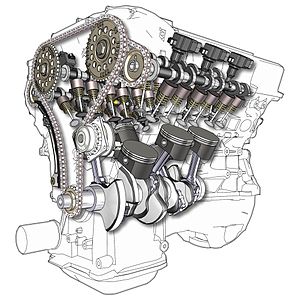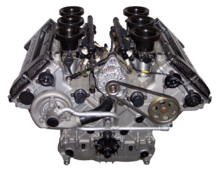
A V6, 24-valve, DOHC engine
A V6 engine is a V engine with six cylinders mounted on the crankshaft in two banks of three cylinders, usually set at either a 60 or 90 degree angle to each other. The V6 is one of the most compact engine configurations, usually ranging from 2.0 L to 4.3 L displacement (however, much larger examples have been produced for use in trucks), shorter than the inline 4 and more compact than the V8 engine. Because of its short length, the V6 fits well in the widely used transverse engine front-wheel drive layout.

Mercedes-Benz V6 DTM engine
Application
The V6 is commercially successful in mid-size cars in the modern age of high fuel prices and price sensitive consumers because it is less expensive to build and has better fuel consumption than the V8, while being smoother in large sizes than the inline 4, which develops increasingly serious vibration problems in larger engines.
The wider 90° V6 will fit in an engine compartment designed for a V8, providing a low-cost alternative to the V8 in an expensive car, while the narrower 60° V6 will fit in most engine compartments designed for an I4, proving a more powerful and smoother alternative engine to the four. While not perfectly smooth, the V6 is smoother than the I4 (inline 4) and adequately smooth for the average consumer.
Buyers of luxury and/or performance cars who are not price sensitive or fuel economy minded might prefer an inline 6, which has comparable fuel economy and power but better smoothness, a flat 6 which combines better smoothness and often higher power with adequate fuel economy, or a V8 which has higher power, but worse fuel economy.
Recent forced induction V6 engines have delivered horsepower and torque output comparable to contemporary larger displacement, naturally aspirated V8 engines, while reducing fuel consumption and emissions, such as the Volkswagen Group’s 3.0 TFSI which is supercharged and directly injected, and Ford Motor Company’s turbocharged and directly injected EcoBoost V6, both of which have been compared to Volkswagen’s 4.2 V8 engine.[1]
Modern V6 engines commonly range in displacement from 2.0 to 4.3 L (120 to 260 cu in), though larger and smaller examples have been produced, such as the 1991 Mazda MX3,[2] and the Rover KV6 engine.
In Europe, where petrol is much more expensive than in the USA, V6 diesels have proved a more popular option. The American-designed Chrysler 300C has a 3-litre Mercedes V6 engine, which vastly outsells the petrol-engined car.
SOURCE: wikipedia
